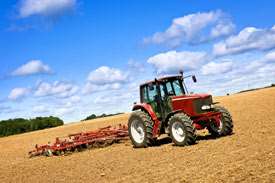By Jessica Merzdorf
Purdue University's annual Indiana Farm Fatality Summary reported 28 farm-related deaths in 2015, a 10 percent increase from the 2014 total of 25. However, overall trends are still declining.

Statistics were collected by the Purdue University Agricultural Safety and Health Program from news reports, Internet searches, personal interviews and reports from individuals and Extension educators.
Tractor and farm machinery accidents continue to be the most commonly reported cause of fatal injury, with overturned tractors accounting for 39 percent of deaths in 2015. All but one documented death from overturns in the past 20 years have involved tractors that were not equipped with a Rollover Protective Structure, a frame or bar that keeps the driver from being crushed if the vehicle flips or rolls over.
Other causes of death in 2015 included falling from buildings or horseback, becoming pinned under equipment, being kicked or rammed by an animal, accidental smoke or chemical inhalation and drowning.
The overall frequency of fatal farm-related injuries has decreased since 1970, partly due to fewer Hoosiers living and working on farms, the report stated. Other factors contributing to the decline include advancements in machine safety and durability, higher expectations for safe and healthy working environments, reduced reliance on child and youth labor, enhanced awareness of risk management in agriculture and advancements in emergency medical care.
"Achieving zero incidents may be an unrealistic goal, but the record clearly shows that the problem is diminishing, however slowly," Purdue Extension safety specialist Bill Field and graduate research assistant Yuan-Hsin Cheng noted in the report. "Many tragic incidents have been prevented during the same time as Indiana farmers have become more productive and efficient than at any time in history."
Agriculture continues to be a dangerous occupation, with a fatality rate of 24.9 per 100,000 agricultural workers nationwide, compared with a death rate of 3.3 out of 100,000 for workers across all industries. Indiana's death rate is slightly lower, at an estimated 19.6 per 100,000 Indiana farm workers in 2015.
The report highlighted several trends and changes affecting farm-related injury and death, including an aging workforce, proliferation of small and "hobby" farms and continued high numbers of accidents involving members of Amish and Old-Order communities.
The age range of victims of fatal farm-related injury in 2015 was 15-85 years, with an average age of 60.6. This average continues to increase, reflecting both an overall increase in the age of farmers and fewer fatal injuries to children and youth. Only one victim in 2015 was under the age of 21.
"The overall decline in the number of children and young adults dying in agricultural workplaces is an extremely positive trend," Field and Cheng said in the report.
Parental and societal attitudes toward children working on farms were suggested as one reason for the falling numbers, as well as the introduction of larger, more complex equipment that children and youth may not be allowed to use.
In contrast, Indiana's Amish and Old-Order Anabaptist communities, many of whom use modern technology selectively due to their religious beliefs, continue to experience higher than average rates of farm-related fatalities. Amish families have more children than average American families and mainly work in agricultural occupations, both risk factors for farm injuries and deaths. Elkhart, LaGrange, Adams and Allen counties have some of the largest Amish populations in the state and also have had the highest number of fatalities over the last 40 years, the report said. In addition to farm accidents, collisions between buggies and motor vehicles are significant sources of injury and death. There were seven incidents in 2015, and five resulted in multiple victims. The authors recommended that more attention be paid to accidents involving members of these communities.
Small, "hobby" and highly diversified farmers also account for a disproportionate share of fatalities - perhaps as high as 25 percent of all fatalities in the last few years, the authors suggested. This could be due to older, less safe machinery, such as tractors not equipped with ROPS, or using alternative green methods, such as horse-drawn equipment. As this population grows, so does the need for educational resources, especially online materials.
To view the report in its entirety or find additional resources to support farm safety, contact the Indiana Rural Safety and Health Council at 765-494-1191 or visit www.farmsafety.org.